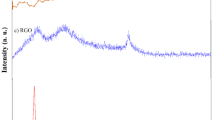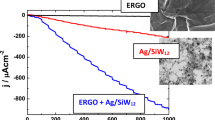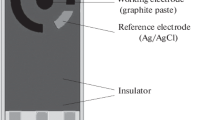Abstract
The preparation of graphene oxide and the modification of its surface directly with copper pentacyanonitrosylferrate (III) nanoparticles are presented in this work, as well as the characterization of the materials using Fourier-transform infrared spectra, X-ray diffractometry and scanning electron microscopy techniques. Beyond that, the study on the electrochemical behavior of the dispersed bimetallic complex on the graphene oxide, as known as GOCuNP, surface was carried out by the cyclic voltammetry technique. The graphite paste electrode modified with GOCuNP was successfully applied in the detection of hydrazine, presenting limit of detection of 1.58 × 10–6 mol L−1 at concentration range of 1.00 × 10–5 to 5.00 × 10–3 mol L−1 of hydrazine, being so the proposed bimetallic complex formed can be considered as a potential candidate for the manufacturing of electrochemical sensors for hydrazine detection.









Similar content being viewed by others
References
Ahn Y, Oh H, Yoon Y, Yoon WK, Yang WS, Kan J-W (2017) Effect of graphene oxidation degree on the catalytic activity of graphene for ozone catalysis. J Environ Chem Eng 5:3882–3894. https://doi.org/10.1016/j.jece.2017.07.038
Hummers WS, Offeman RE (1958) Preparation of graphitic oxide. J Am Chem Soc 80:1339–1339. https://doi.org/10.1021/ja01539a017
Marcano DC, Kosynkin DV, Berlin JM, Sinitskii A, Sun Z, Slesarev A, Alemany LB, Lu W, Tour JM (2010) Improved synthesis of graphene oxide. ACS Nano 4:4806–4814. https://doi.org/10.1021/nn1006368
Yuan R, Yuan J, Wu Y, Chen L, Zhou H, Chen J (2017) Efficient synthesis of graphene oxide and the mechanisms of oxidation and exfoliation. Appl Surf Sci 416:868–877. https://doi.org/10.1016/j.apsusc.2017.04.181
Zhengtang L, Vora PM, Mele EJ, Johnson ATC, Kikkawa JM (2009) Photoluminescence and bandgap modulation in graphene oxide. Appl Phys Lett 94(11):111909. https://doi.org/10.1063/1.3098358
Zhou X, Huang X, Qi X, Wu S, Xue C, Boey FYC, Yan Q, Chen P, Zhang H (2009) In situ synthesis of metal nanoparticles on single-layer graphene oxide and reduced graphene oxide surfaces. J Phys Chem C 113(25):10842–10846. https://doi.org/10.1021/jp903821n
Romero A, Lavin-Lopez MP, Sanchez-Silva L, Valverde JL, Patoncarrero A (2018) Comparative study of different scalable routes to synthesize graphene oxide and reduced graphene oxide. Mater Chem Phys 203:284–292. https://doi.org/10.1016/j.matchemphys.2017.10.013
Ribeiro BFM, Souza MM, Fernandes DS, Carmo DR, Machado’Santelli GM (2019) Graphene oxide-based nanomaterial interaction with human breast cancer cells. J Biomed Mater Res 108:863–870. https://doi.org/10.1002/jbm.a.36864
Iwan A, Chuchmała A (2012) Perspectives of applied graphene: polymer solar cells. Prog Polym Sci 37(12):1805–1828. https://doi.org/10.1016/j.progpolymsci.2012.08.001
Iwan A, Szubzda B, Sikora A (2014) Graphene science handbook. CRC Press, Taylor & Francis, Florida
Gong X, Bi Y, Zhao Y, Liu G, Teoh WY (2014) Graphene oxide-based electrochemical sensor: a platform for ultrasensitive detection of heavy metal ions. RSC Adv 4(47):24653–24657. https://doi.org/10.1039/c4ra02247e
Tan P, Bi Q, Hu Y, Fang Z, Chen Y, Cheng J (2017) Effect of the degree of oxidation and defects of graphene oxide on adsorption of Cu2+ from aqueous solution. Appl Surf Sci 423:1141–1151. https://doi.org/10.1016/j.apsusc.2017.06.304
Khodavirdiloa B, Samadib N, Ansaria R (2019) Synthesis of graphene oxide-melamine–tio oxalic acid nanocomposite and its application in the elimination of mercury (II) ions. Eurasian Chem Commun 7:71–78. https://doi.org/10.30473/icc.2019.4358
Zang H, Li Y, Li Y, Chen L, Du Q, Zhou K, Li H, Wang Y, Ci L (2019) Adsorptive removal of cationic dye from aqueous solution by graphene oxide/cellulose acetate composite. J Nanosci Nanotechnol 19(8):4535–4542. https://doi.org/10.1166/jnn.2019.16632
Chen D, Feng H, Li J (2012) Graphene oxide: preparation, functionalization, and electrochemical applications. Chem Rev 112(11):6027–6053. https://doi.org/10.1021/cr300115g
Talyzin AV, Mercier G, Klechikov A, Hedenström M, Johnels D, Wei D, Cotton D, Opitz A, Moons E (2017) Brodie vs hummers graphite oxides for preparation of multi-layered materials. Carbon 115:430–440. https://doi.org/10.1016/j.carbon.2016.12.097
Tang YP, Paul DR, Chung TS (2014) Free-standing graphene oxide thin films assembled by a pressurized ultrafiltration method for dehydration of ethanol. J Membr Sci 458:199–208. https://doi.org/10.1016/j.memsci.2014.01.062
Nair RR, Wu HA, Jayaram PN, Grigorieva IV, Geim AK (2012) Unimpeded permeation of water through helium-leak-tight graphene-based membranes. Science 335(6067):442–444. https://doi.org/10.1126/science.1211694
Urbanová V, Bakandritsos A, Jakubec P, Szambó T, Zbořil R (2017) A facile graphene oxide based sensor for electrochemical detection of neonicotinoids. Biosens Bioelectron 89:532–537. https://doi.org/10.1016/j.bios.2016.03.039
Do Carmo DR, Fernandes DS (2017) Hybrid graphene oxide/DAB-Am-16 dendrimer: preparation, characterization chemical reactivity and their electrocatalytic detection of l-dopamine. Solid State Sci 71(33):41. https://doi.org/10.1016/j.solidstatesciences.2017.07.005
Fernandes DS, Bonfim KS, Do Carmo DR (2018) Silver hexacyanoferrate (III) on a hybrid graphene oxide/PAMAM dendrimer surface and application as an electrocatalyst in the detection of isoniazid. Electroanalysis 30:1107–1116. https://doi.org/10.1002/elan.201800005
Mo R, He L, Yan X, Su T, Zhou C, Wang Z, Hong P, Sun S, Li C (2018) A novel aflatoxin B1 biosensor based on a porous anodized alumina membrane modified with graphene oxide and an aflatoxin B1 aptamer. Electrochem Commun 95:9–13. https://doi.org/10.1016/j.elecom.2018.08.012
Beitollahi H, Garkani-Nejad F, Tajik S, Ganjali MR (2019) Voltammetric determination of acetaminophen and tryptophan using a graphite screen printed electrode modified with functionalized graphene oxide nanosheets within a Fe3O4@SiO2 nanocomposite. Iran J Pharm Res 18(1):80–90. https://doi.org/10.22037/ijpr.2019.2326
Tajik S, Beitollahi H (2019) A Sensitive chlorpromazine voltammetric sensor based on graphene oxide modified glassy carbon electrode. Anal Chem Res 6(1):171–182. https://doi.org/10.22036/abcr.2018.89229.1154
Sarno M, Ponticorvo E (2019) Metal–metal oxide nanostructure supported on graphene oxide as a multifunctional electro-catalyst for simultaneous detection of hydrazine and hydroxylamine. Electrochem Commun 107:106510. https://doi.org/10.1016/j.elecom.2019.106510
Chang XJ, Wang ZX, Quan S, Xu YC, Jiang ZX, Shao L (2014) Exploring the synergetic effects of graphene oxide (GO) and polyvinylpyrrolidone (PVP) on polyvinylylidenefluoride (PVDF) ultrafiltration membrane performance. Appl Surf Sci 316:537–548. https://doi.org/10.1016/j.apsusc.2014.07.202
Mogha NK, Gosain S, Masram DT (2017) Gold nano worms immobilized graphene oxide polymer brush nanohybrid for catalytic degradation studies of organic dyes. Appl Surf Sci 396:1427–1434. https://doi.org/10.1016/j.apsusc.2016.11.182
Kim JD, Yun H, Kim GC, Lee CW, Choi HC (2013) Antibacterial activity and reusability of CNT-Ag and GO-Ag nanocomposites. Appl Surf Sci 283:227–233. https://doi.org/10.1016/j.apsusc.2013.06.086
Trapalis A, Todorova N, Giannakopoulou T, Boukos N, Speliotis T, Dimotikali D, Yu J (2016) TiO2/graphene composite photocatalysts for NOx removal: a comparison of surfactant-stabilized graphene and reduced graphene oxide. Appl Catal B-Environ 180:637–647. https://doi.org/10.1016/j.apcatb.2015.07.009
Jie-Yao L, Shuwen C, Wei H, Xue-Xue Z, De-Yun T, Pei-Jin L, Qi-Long Y (2019) Fabrication of high-performance graphene oxide doped PVDF/CuO/Al nanocomposites via electrospinning. Chem Eng J 368:129–137. https://doi.org/10.1016/j.cej.2019.02.170
Ding Y, Hu Y-L, Gu G, Xia X-H (2009) Controllable synthesis and formation mechanism investigation of Prussian blue nanocrystals by using the polysaccharide hydrolysis method. J Phys Chem C 113(33):14838–14843. https://doi.org/10.1021/jp905704c
Domínguez-Vera JM, Colacio E (2003) Nanoparticles of Prussian Blue Ferritin: a new route for obtaining nanomaterials. Inorg Chem 42(22):6983–6985. https://doi.org/10.1021/ic034783b
Vaucher S, Fielden J, Li M, Dujardin E, Mann S (2002) Molecule-based magnetic nanoparticles: synthesis of cobalt hexacyanoferrate, cobalt pentacyanonitrosylferrate, and chromium hexacyanochromate coordination polymers in water-in-oil microemulsions. Nano Lett 2(3):225–229. https://doi.org/10.1021/nl0156538
Paim LL, Stradiotto NR (2010) Electrooxidation of sulfide by cobalt pentacyanonitrosylferrate film on glassy carbon electrode by cyclic voltammetry. Electrochim Acta 55(13):4144–4147. https://doi.org/10.1016/j.electacta.2010.02.082
Xun Z, Cai C, Lu T (2004) Effects of a surfactant on the electrocatalytic activity of cobalt hexacyanoferrate modified glassy carbon electrode towards the oxidation of Dopamine. Electroanalysis 16(8):674–683. https://doi.org/10.1002/elan.200302821
Carapuça HM, Filipe OMS, Simão JEJ, Fogg AG (2000) Electrochemical studies of nitroprusside in the presence of copper(II): formation of Cu(I) reduced nitroprusside species. J Electroanal Chem 480:84–93. https://doi.org/10.1016/S0022-0728(99)00448-9
Do Carmo DR, Da Silva RM, Stradiotto NR (2005) Electrochemical behaviour of copper nitroprusside generated in situ onto the graphite paste electrode surface and its application in determination of n-acetylcysteine. Port Electrochim Acta 23(4):457–470. https://www.scielo.mec.pt/scielo.php?script=sci_arttext&pid=S0872-19042005000400004&lng=pt&nrm=iso
Do Carmo DR, Da Silva RM, Stradiotto NR (2002) Estudo eletroquímico de Fe[Fe(CN)5NO] em eletrodo de pasta de grafite. Eclét Quím 27:197–210. https://doi.org/10.1590/S0100-46702002000200017
Mullaliu A, Sougrati MT, Louvain N, Aquilanti G, Doublet ML, Stievano L, Giorgetti M (2017) The electrochemical activity of the nitrosyl ligand in copper nitroprusside: a new possible redox mechanism for lithium battery electrode materials? Electrochim Acta 257:364–371. https://doi.org/10.1016/j.electacta.2017.10.107
Gholivand MB, Azadbakht A (2011) A novel hydrazine electrochemical sensor based on a zirconium hexacyanoferrate film-bimetallic Au–Pt inorganic-organic hybrid nanocomposite onto glassy carbon-modified electrode. Electrochim Acta 56(27):10044–10054. https://doi.org/10.1016/j.electacta.2011.08.098
Ardakani MM, Karimi MA, Zare MM, Mirdehghan SM (2008) Investigation of electrochemical behavior of hydrazine with alizarin as a mediator on glassy carbon electrode. Int J Electrochem Sci 3(3):246–258. https://www.electrochemsci.org/papers/vol3/3030246.pdf
Li J, Xie H, Chen L (2011) A sensitive hydrazine electrochemical sensor based on electrodeposition of gold nanoparticles on choline film modified glassy carbon electrode. Sens Actuators B-Chem 153(1):239–245. https://doi.org/10.1016/j.snb.2010.10.040
Ozoemena KI (2006) Anodic oxidation and amperometric sensing of hydrazine at a glassy carbon electrode modified with cobalt (II) phthalocyanine–cobalt (II) tetraphenylporphyrin (CoPc-(CoTPP)4) supramolecular complex. Sensors 6(8):874–891. https://doi.org/10.3390/s6080874
Sun H, Dong L, Yu H, Huo M (2013) Direct electrochemical oxidation and detection of hydrazine on a boron-doped diamond (BDD) electrode. Russ J Electrochem 49(9):883–887. https://doi.org/10.1134/S1023193513030154
Liu XW, Yao ZJ, Wang YF, Wei XW (2010) Graphene oxide sheet-Prussian blue nanocomposites: green synthesis and their extraordinary electrochemical properties. Colloids Surf B-Biointerfaces 81:508–512. https://doi.org/10.1016/j.colsurfb.2010.07.049
Silverstein RM, Webster FX, Kiemle DJ (2005) Spectrometric identification of organic compounds. Wiley, New York
Storm MM, Johnsen RE, Norby P (2016) In situ X-ray powder diffraction studies of the synthesis of graphene oxide and formation of reduced graphene oxide. J Solid State Chem 240:49–54. https://doi.org/10.1016/j.jssc.2016.05.019
Gómez A, Rodríguez-Hernández J, Reguera E (2004) Unique coordination in metal nitroprussides: the structure of Cu[Fe(CN)5NO]·2 H2O and Cu[Fe(CN)5NO]. J Chem Crystallogr 34(12):893–903. https://doi.org/10.1007/s10870-004-7724-2
Do Carmo DR, Souza MM, Bicalho UO, Dos Santos VS, Souza JP, Silvestrini DR (2015) Direct preparation and characterization of copper pentacyanonitrosylferrate nanoparticles. J Nanomater 2015(5):1–6. https://doi.org/10.1155/2015/502424
Sheng Y, Tang Y, Peng E, Xue J (2013) Graphene oxide-based fluorescent nanocomposites for cellular imaging. J Mater Chem B 1(4):512–521. https://doi.org/10.1039/C2TB00123C
Guerrero-Contreras J, Caballero-Briones F (2015) Graphene oxide powders with different oxidation degree, prepared by synthesis variations of the Hummers method. Mater Chem Phys 153:209–220. https://doi.org/10.1016/j.matchemphys.2015.01.005
Botas C, Álvarez P, Blanco P, Granda M, Blanco C, Santamaría R, Romasanta LJ, Verdejo R, López-Manchado MA, Menéndez R (2013) Graphene materials with different structures prepared from the same graphite by the Hummers and Brodie methods. Carbon 65:156–164. https://doi.org/10.1016/j.carbon.2013.08.009
Engel D, Grabner EW (1985) Copper hexacyanoferrate-modified glassy carbono: a novel type of potassium-selective electrode. Ber Bunsen Phys Chem 89(9):982–986. https://doi.org/10.1002/bbpc.19850890911
Lovrić M, Scholz F (1999) A model for the coupled transport of ions and electrons in redox conductive microcrystals. J Solid State Electrochem 3:172–175. https://doi.org/10.1007/s100080050144
Lovrić M, Scholz F (1997) A model for the propagation of a redox reaction through microcrystals. J Solid State Electrochem 1:108–113. https://doi.org/10.1007/s100080050030
Oldham KB (1998) Voltammetry at a three-phase junction. J Solid State Electrochem 2:367–377. https://doi.org/10.1007/s100080050113
Bard AJ, Faulkner LR (1980) Electrochemical methods: fundamentals and applications. Wiley, New York
Baldwin RP, Ravichandran K, Johnson RK (1984) A cyclic voltammetry experiment for the instrumental analysis laboratory. J Chem Educ 61(9):820–823. https://doi.org/10.1021/ed061p820
De Sá AC, Maraldi VA, Bonfim KS, Souza TR, Paim LL, Barbosa PFP, Nakamura AP, Do Carmo DR (2017) Electrocatalytic detection of hydrazine using chemically modified electrodes with cobalt pentacyanonitrosylferrate adsorbed on the 3-aminopropylsilica surface. Int J Chem 9(4):12–21. https://doi.org/10.5539/ijc.v9n4p12
Razmi-Nerbin H, Pournaghi-Azar MH (2002) Nickel pentacyanonitrosylferrate film modified aluminum electrode for electrocatalytic oxidation of hydrazine. J Solid State Electrochem 6:126–133. https://doi.org/10.1007/s100080100201
Magossi MS, Fernandes DS, Do Carmo DR (2019) Synthesis of a novel hybrid nanocomposite based on copper pentacyanonitrosylferrate and octa(aminopropyl)silsesquioxane and its behavior on l-cysteine electrooxidation. Solid State Sci 95:105931. https://doi.org/10.1016/j.solidstatesciences.2019.105931
Rastogi PK, Ganesan V, Krishnamoorthi S (2014) Palladium nanoparticles decorated guar gum-based hybrid material for electrocatalytic hydrazine determination. Electrochim Acta 125:593–600. https://doi.org/10.1016/j.electacta.2014.01.148
Panchompoo J, Aldous L, Downing C, Crossley A, Compton RG (2011) Facile synthesis of pd nanoparticle modified carbon black for electroanalysis: application to the detection of hydrazine. Electroanalysis 23(7):1568–1578. https://doi.org/10.1002/elan.201100163
Malik P, Srivastava M, Verma R, Kumar M, Kumar D, Singh J (2016) Nanostructured SnO2 encapsulated guar gum hybrid nanocomposites for electrocatalytic determination of hydrazine. Mater Sci Eng C 58:432–441. https://doi.org/10.1016/j.msec.2015.08.035
Jayasri D, Narayanan SS (2007) Amperometric determination of hydrazine at manganese hexacyanoferrate modified graphite-wax composite electrode. J Hazard Mater 144(1–2):348–354. https://doi.org/10.1016/j.jhazmat.2006.10.038
Rostami S, Aziz SN, Ghasemi S (2017) Simultaneous electrochemical determination of hydrazine and hydroxylamine by CuO doped in ZSM-5 nanoparticles as a new amperometric sensor. New J Chem 41:13712–13723. https://doi.org/10.1039/C7NJ02685D
Yi Q, Niu F, Yu W (2011) Pd-modified TiO2 electrode for electrochemical oxidation of hydrazine, formaldehyde and glucose. Thin Solid Films 519:3155–3161. https://doi.org/10.1016/j.tsf.2010.12.241
Sljukic B, Banks CE, Crossley A, Compton RG (2006) Iron(III) oxide graphite composite electrodes: application to the electroanalytical detection of hydrazine and hydrogen peroxide. Electroanalysis 18(18):1757–1762. https://doi.org/10.1002/elan.200603605
Beduk T, Bihar E, Surya SG, Castillo AN, Inal S, Salama KN (2020) A paper-based inkjet-printed PEDOT:PSS/ZnO sol-gel hydrazine sensor. Sens Actuators B-Chem 306:127539. https://doi.org/10.1016/j.snb.2019.127539
Ghasemi S, Hosseini SR, Hasanpoor F, Nabipour S (2019) Amperometric hydrazine sensor based on the use of Pt–Pd nanoparticles placed on reduced graphene oxide nanosheets. Microchim Acta 186:601. https://doi.org/10.1007/s00604-019-3704-2
Brugnera MF, Santos DP, Zanoni MVB (2006) Eletrodo modificado com filme de poli aminoácido para determinação de hidrazina em água de caldeira. Eclét Quím 31(4):63–68. https://doi.org/10.1590/S0100-46702006000400010
Acknowledgements
The author would like to express the gratitude for the financial support by the São Paulo Research Foundation (FAPESP-grant 2015/20397-8) and the Coordenação de Aperfeiçoamento de Pessoal de Nível Superior—Brasil (CAPES).
Funding
This work was supported by the São Paulo Research Foundation (FAPESP), grant 2015/20397-8) and by the Coordenação de Aperfeiçoamento de Pessoal de Nível Superior—Brasil (CAPES)—Finance Code 001.
Author information
Authors and Affiliations
Contributions
All authors contributed to the study conception and design. Material preparation, data collection and analysis were performed by VAM under supervision of DRdC. The first draft of the manuscript was written by VAM, then it was reviewed and edited by DRdC. All authors read and approved the final manuscript.
Corresponding author
Ethics declarations
Conflict of interest
The authors declare that they have no conflict of interest.
Additional information
Publisher's Note
Springer Nature remains neutral with regard to jurisdictional claims in published maps and institutional affiliations.
Rights and permissions
About this article
Cite this article
Maraldi, V.A., do Carmo, D.R. Modification of the graphene oxide surface with copper pentacyanonitrosylferrate nanoparticles for electro-oxidation of hydrazine. Carbon Lett. 31, 795–807 (2021). https://doi.org/10.1007/s42823-020-00198-y
Received:
Revised:
Accepted:
Published:
Issue Date:
DOI: https://doi.org/10.1007/s42823-020-00198-y




